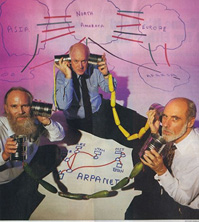- In contemplation
of the need for a mechanism for aggregating funding from many sources,
it was proposed to form an Internet Society and to use its resources, in
part, to provide funds in support of IETF.
- The plan was
for the Society to engage in a variety of activities including conferences,
workshops, and raise funds from industry and other institutional sources.
It does so on an international basis, and acts as a neutral and internationally
recognized body, devoted to the support of Internet administrative infrastructure,
including, for example, IAB, IETF, IRTF and IANA. Ideas for the formation
of this organization were discussed in IAB and IETF meetings early in 1991
and plans were announced at the INET Conference in June 1991 in Copenhagen.
- The Internet
Society was officially formed in January 1992. In June, 1992, at the annual
meeting of the Internet Society, INET'92, in Kobe, Japan, the Internet
Activities Board proposed to associate its activities with ISOC and was
renamed the Internet Architecture Board.
- Historically,
the IETF and its sister organization, the Internet Research Task Force,
had been considered two arms of the IAB.
|
![]()
![]()

